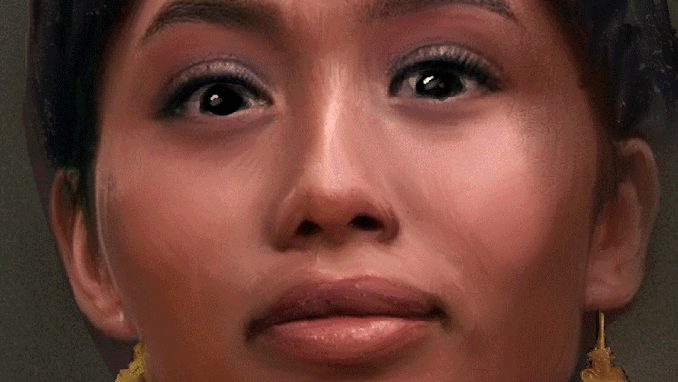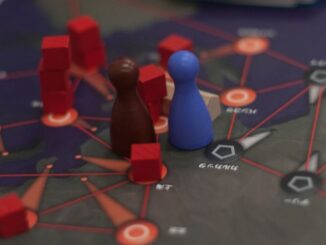
Let’s make a game. Let’s make a strategy game or board game, about the middle ages. As it is a game, we assume it needs conflict, and we assume that that means that the Kings of different countries will be battling between themselves. That seems like common sense.
So let’s lay out the map. We’ll divide it into spaces, and we’ll play characters (in a computer game) or tokens (in a board game) into those spaces. Here you have your King – the most powerful piece under your control. And here you have some subordinate pieces – maybe a couple of royal Princes, a Queen, some other nobles, armies, castles. And now we start playing, moving the pieces around. A key point is going to come when a player’s King is defeated, but again we can assume that we know what happens then: when a medieval king dies, the eldest son inherits, so what we will do in this game is to say that when a King token is lost then on the next turn the eldest Prince is upgraded to become the King (e.g. we remove the Prince token, and place a King token in the same space).

Everything that is outlined in the paragraph above makes total sense to us. But it makes sense not because it reflects any actual reality within the medieval period, but because it fits our assumptions. And this is a problem, because if we are creating a game which claims to somehow depict a reality (historical or present) then if we aren’t consciously deriving the game’s mechanics from that reality then our games suffer. Firstly, they become misleading – they simply perpetuate myths and assumptions, rather than really illuminating a subject. Secondly, they become boring, because they never show our players anything new.
Now, in comparison with our assumed medieval game above, we could take a real medieval society, and consciously derive out core mechanics from that. This is what we did when we designed Queen’s Rule for mobile devices. And the result, as we’ll see, gives us a surprising, engaging gameplay mechanic which illuminates a historical period.
Deriving a Mechanic From History

For the game Queen’s Rule we focused on the Indianic societies of the early middle ages. In particular, we picked matrilineal societies.
A society is “matrilineal” if inherence passes through the female line. In other words, women, not men, inherit. And in this case the cultures are also “exogamous”, meaning that people marry outside their kinship groups.
Matrilineal is not the same thing as matriarchal. Inheritance is not the same as rule. But this means that when a king dies, the new king is not one of your own princes but a foreign prince who is chosen to marry the female heir.
Immediately we can see that core game mechanic will differ dramatically from our “assumed medieval” mechanic, above. In the “assumed” version, when your King token is eliminated your designated Prince transforms into a King. In Queen’s Rule, when the King dies a foreign Prince marker is selected and moved to the location of the Queen. In fact in Queen’s Rule all of the tokens (King and Prince) spawn from the Queen’s location, so that the position of the Queen on the map becomes vital. Meanwhile, in our “assumed” version the Prince (heir) is your king-in-waiting and you will both protect him and position him carefully; in contrast in Queen’s Rule the Prince token becomes an unreliable asset since he could at any time be suborned by another player to replace their own dead King.
This does not give us a reliable simulation that we can use to draw firm conclusions about historical societies. Creating a game is an exercise in omission. In order to reduce a complex situation to a comprehensible set of game mechanics, we must ignore most of the actual situation. And so our abstract game does not show us exactly how people behaved. When you play Queen’s Rule you might become somewhat cavalier about the safety of your Prince – if he can be taken away by other players so easily, you will put less effort into protecting him – but we shouldn’t assume from this that parents in matrilineal dynasties are uncaring of their sons. So let us not assume that playing the game reliably instructs us about the reality of life in the setting.
But this approach does deliver two benefits.
First, it creates unexpected challenges for the player. If we only ever deliver games which match our assumptions, then we can never surprise the players. Allowing ourselves to be challenged and inspired by real settings is a useful trick in pushing ourselves to creating new mechanics.
Second, it prompts the players to reflect. If they only ever see games which confirm their own assumptions, then they are not nudged to consider alternative possibilities. In other words, this helps them to grow and develop in their view of the world.
Revisiting Assumptions
It could be argued that with Queen’s Rule we have cheated somewhat. We have selected a society with such an unfamiliar (to us) set of assumptions around dynasty and inheritance, that of course the game mechanics to reflect that will be different.
But in fact, even in “familiar” settings taking the reality of the situation gives us more varied and more interesting mechanics than simply defaulting to our assumptions. A glance at any genre shows plenty of examples of games which simply take mechanics which are common in the genre and reskinning them to resemble a new setting or Intellectual Property. Whether it is a 4x PC strategy game or a worker-placement board game, people will often start constructing the game based on existing mechanics, rather than focusing first of all on the subject.
Consider, instead, what happens when we take our familiar, “assumed” medieval setting and apply some historical reality to it.
We tend to assume that the medieval period meant medieval Europe. And we tend to assume that in medieval Europe inheritance is patrilineal (father to son) and that the first-born inherit. There is a double layer of assumption here, and this myth – this idea that medieval Europe establishes a norm, and that medieval societies operated in a way in which a Victorian historian might have approved – is neither accurate nor especially interesting.
So our assumption, above. was: when the king dies, the eldest son inherits; so if the King token is removed from the game, on the next turn we should upgrade the senior Prince token to be the new King. But in reality, medieval Europeans developed a range of systems to select kings. As real historical examples:
- Both Anglo Saxon England and the Holy Roman Empire, as examples, had systems of election, where the king was chosen by a kind of committee from among a range of eligible candidates – with the criteria for eligibility being rather fluid.
- Kings sometimes nominated their successors, demanding that their subjects swear to accept someone who wasn’t a first-born son.
- A lot of kingships began not with a dignified hand-over of power, but with a desperate race to be the first person to be credibly crowned.
- And ultimately most inheritances had to be fought for, and if we strip away the pomp and idealised imaginings, the death of a king is a trigger for bloodshed and becoming king essentially involved being more effective in the use of violence than any other contenders.
This gives us four possible paradigms for our turn-based game, from which we can derive mechanics. As some quick examples:

- Election: Any aristocratic token that you have in play can become the King. Give each token certain attributes which determine the support that they receive from the electoral council; as a player you then have to ensure the placement of your nobles so that, in the event of your King’s death, a powerful rather than powerless token is upgraded to be King.
- Nomination: Add a marker to your chosen Heir at the start of your turn. If your King is eliminated before the start of your next turn and the Heir still lives, then the Heir neatly becomes King; but if the Heir is ineligible (e.g. has also been killed, or in more complex games is subject to another relevant condition) then you can pick any noble token to upgrade but you skip a turn or are otherwise inconvenienced.
- Race: Each player has a space on the map where the new King must be crowned. You can upgrade an aristocrat to a King only by moving a token to that space, and if you can move an eligible token to that space then you must. And if you lose control of your coronation space, then you can’t promote a new King.
- Conflict: When the king dies, consider the number of tokens who have achieved a certain criteria – e.g. command of a certain number or armies, or are located in map spaces with particular attributes (e.g. wealth, a castle, etc.). If only one meets the criteria then he becomes King; if more than one is eligible, then each turn eliminate the least powerful/qualified token from the map, until only one remains, but in the turns when that is occurring those tokens and their armies cannot move. (In other words, if you don’t have your tokens arranged in a way that allows for easy succession at the time when the king dies, your kingdom will be wracked by civil war.)

There may be more elegant or interesting mechanics to be derived from those systems of inheritance, but the examples above do, hopefully, make the point: looking at messy historical realities drives us, as game designers, to imagine more interesting challenges for our players, and then prompts the players to think beyond the easy assumptions that we all naturally make.
When we designed Queen’s Rule we did so deliberately to explore how looking at less obvious cultures and societies could lead to an unusual and intriguing strategy game, that prompts players to explore different strategies and to reflect on history in a new way. But there is nothing magical or unique about the societies that we chose to explore: any setting, present or historical, should yield unique elements which, if we choose to push ourselves and our players beyond our assumptions, allow us to construct fresh game mechanics and to look at the world anew.
Queen’s Rule is not yet released, but you can check progress at https://yosanostudios.com/project/queens-rule/
- Are Game Mechanics Assumed or Extrapolated? - 4th May 2022





Be the first to comment